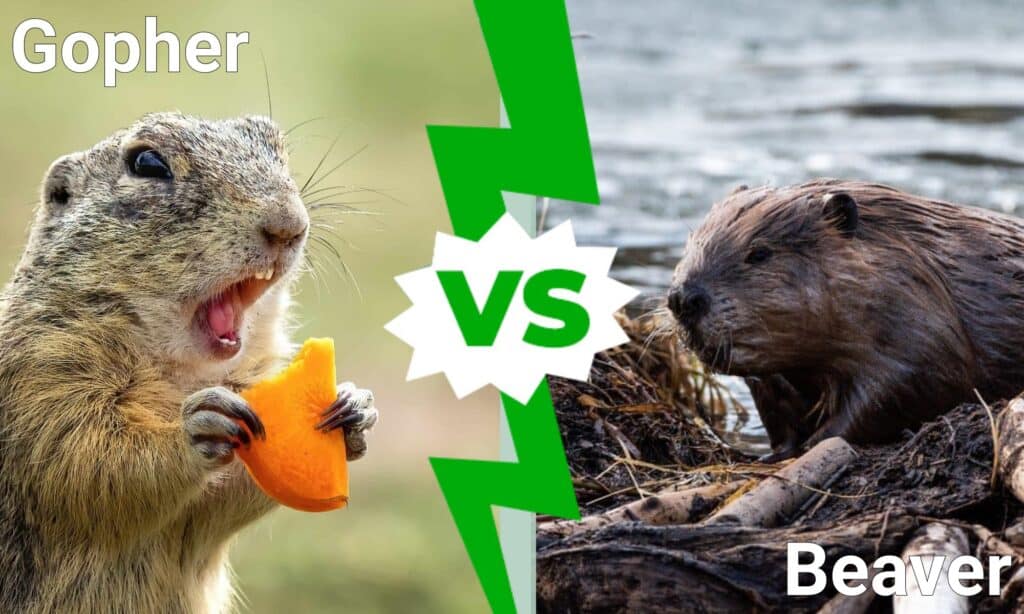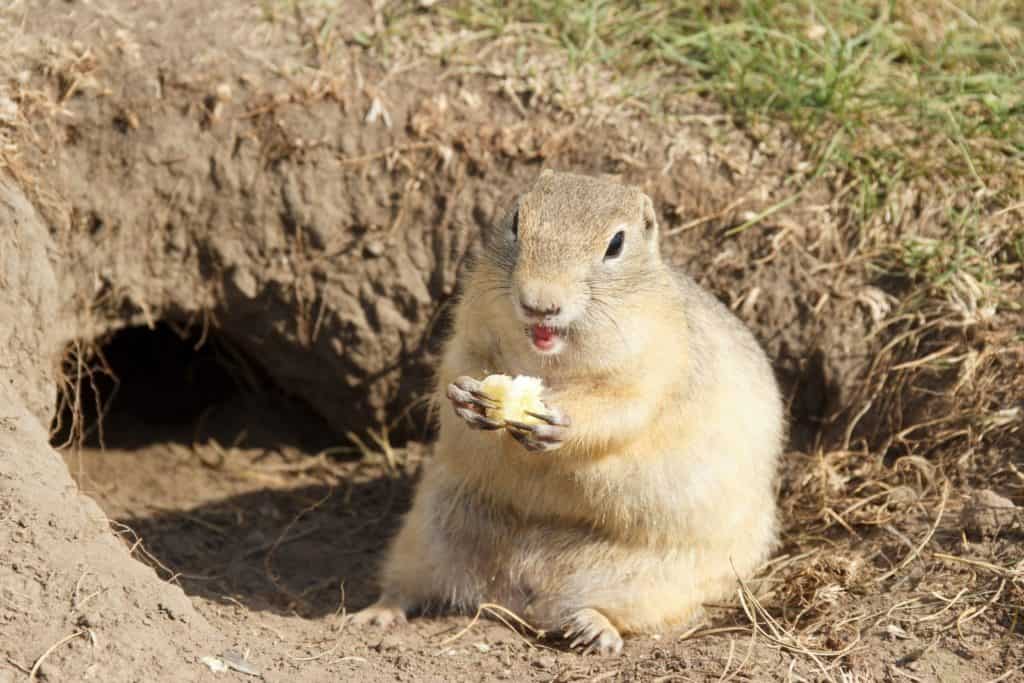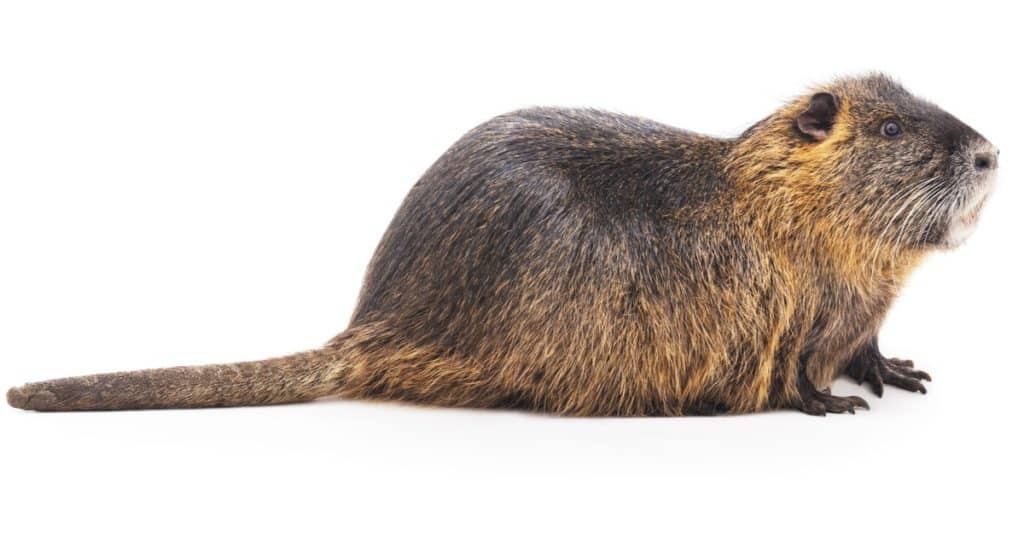Rodents make up 40% of the world’s animal population. They have long tails, strong bodies, and small limbs, and they inhabit fabricated and terrestrial settings. Squirrels, rats, mice, beavers, hamsters, groundhogs, and chipmunks are all types of rodents. Each species has a unique set of features that helps humans distinguish one from another. In this article, we explore eight key differences between two well-known rodents. Let’s learn all there is to know about the gopher vs. beaver.
A Comparison

| Gopher | Beaver | |
|---|---|---|
| Size | 5 to 14 inches long / 1-2 lbs. | 2.4 – 4 ft. / 24 – 66 lbs. |
| Colors | Light to Dark Brown, Buff Underside | Yellow, Brown, Black |
| Physical Features | Small Body, Tiny Ears and Eyes, Hairless Tail | Big Head, Robust Body, Large and Flat Tail |
| Danger | Can Carry Diseases, Mostly Causes Landscape Damage | Can Be Aggressive and Attack |
| Diet | Plants, Mostly Roots, and Tubers | Leaves, Woody Stems, Vegetation |
| Lifespan | 1 – 3 Years | 15-20 Years |
| Habitats | North/Central America, in Loose Soil | Northern Hemisphere; Near Water |
| Habits | Most Active in Spring/Evenings; Spends Time Tunneling/ Foraging | Most Active at Night, Spends Time Foraging and Building Lodging |
Key Differences Between Gopher vs. Beaver
The key differences between gophers and beavers are their size, appearance, habitat, lifespan, diet, habits, and physical features.
Gophers and beavers have several similar characteristics. As an example, both are rodents and herbivores. And they are both responsible for damaging human settlements. Additionally, they are each vital parts of the ecosystem. Now, we’ll talk about what sets them apart, including their appearances, features, and habitats!
Size

In terms of weight, gophers weigh about a pound.
©eumates/Shutterstock.com
Gophers are medium-sized rodents. Between 5 and 14 inches in length, they are larger than mice but smaller than rats. In terms of weight, they’re somewhere about a pound or so. Gophers can reach 2.2 pounds in some Central American species.
Beavers grow and mature to a total length of 3 to 4 feet, including the tail. The average adult beaver weighs anywhere between 24 to 66 pounds!
Colors
Beavers occur in a range of colors, from yellowish-brown to black, with the most common being reddish-brown. Gophers, sometimes known as pocket gophers, range in hue from light brown to deep brown, while their undersides are a paler buff.
Physical Features
Gophers have tiny eyes and ears, short noses, flat skulls, and small bodies. Their tails, which are typically dark with a white tip, are nearly hairless. Gophers have external cheek chambers lined with fur that stretch to their shoulders. They use these pouches to carry food.
Beavers have large heads, short necks, thick, robust bodies, and tiny ears and eyes. Perhaps its most distinguishing feature is a large, flat, hairless tail curved like a paddle. The American beaver is the largest rodent in the country, growing to a length of 2-3 feet without its tail. Its fur is waterproof, and its feet are webbed.
Danger
Gophers can contract rabies. They are disease carriers and can infect others by biting. Also, when gophers build tunnels, they do damage to your landscape. To start, the holes they dig in the earth jeopardize your yard’s structural integrity. Plus, if a cave-in occurs, you may end up with larger surface holes.
Beavers can bite, attack, and even kill humans. Although rare, if you infringe on a beaver’s turf, expect an aggressive response. Beavers also erode and destabilize banks and levees. This inevitably destroys property and transit corridors such as roads, airports, and trains.
Diet

Gophers are herbivores.
©ToKa74/Shutterstock.com
Beavers are herbivores and eat leaves, woody stems, and aquatic vegetation. There are a few kinds of wood that they use for construction and food: poplar, aspen, birch, and maple are among their favorites.
Herbivores, like gophers, eat only plant matter. They occasionally eat plants’ tops, but their primary diet consists of the roots and tubers of the plant. It’s common for gophers to peek out of a “feed hole” to snag a neighboring plant.
Lifespan
The average lifespan of a gopher is between two and three years. Five weeks after birth, the young are ready to begin digging their own burrows. A beaver reaches adulthood after two to three years and lives for about 15-20 years.
Habitat

Beavers live in ponds and streams.
©Oleksandr Lytvynenko/Shutterstock.com
A beaver’s home is known as a lodge. To begin the process of constructing a lodge, the beaver must first find a suitable location. It’s common for beavers to seek a spot that’s near a food source. Beavers are common in ponds, lakes, rivers, and streams, except in the Southwest Desert.
Geographically, gophers reside throughout North and Central America, primarily in areas with loose, sandy soil. Their burrows are made of a series of tunnels.
Habits
Gophers are rarely out in the open, but when they are, it’s usually because they’re busy tunneling or eating. At any time of the day or year, they can burrow. Springtime is their busiest time of year, and they can make up to three mounds every day at their peak. In addition, they appear to be most at night, particularly after sunset.
Beavers sleep during the day and forage or labor at night. They are quite active when awake. A beaver colony can build a lodge in a few days. The beaver’s most distinctive characteristic is a long, flat, black tail. A beaver utilizes its tail to swim faster and to slap the water to make a loud alarm. The beaver’s long tail also helps balance a heavy log or trunk.
Wrapping Up Gopher vs. Beaver
Gophers and beavers are both unwelcome news for home and property owners. This is due to the extensive harm they cause plants, landscapes, and even lawns. A hazard may arise from the holes gophers excavate because it is difficult to see them. As vital as they may be to the ecosystem, rodents conflict with humans in ways that must not be overlooked. As a result, pests should be caught and securely removed using traps.
The photo featured at the top of this post is © eumates/Shutterstock.com
Thank you for reading! Have some feedback for us? Contact the AZ Animals editorial team.






